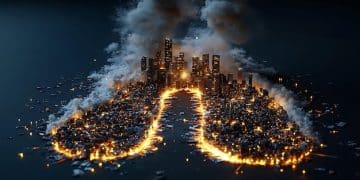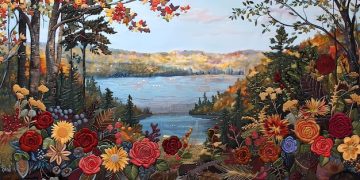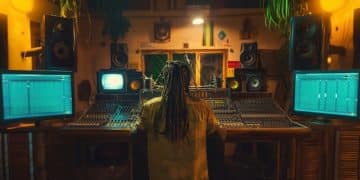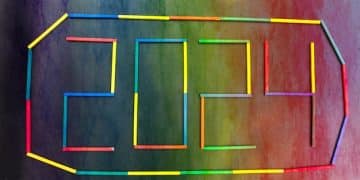Rediscovering Lost Art: Practical Effects in Cinema Before CGI
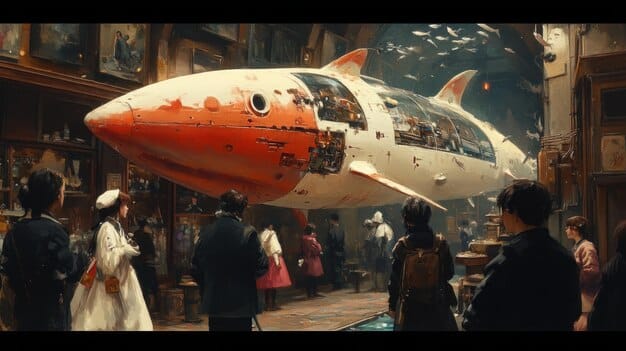
Practical effects, utilizing physical objects, miniatures, and in-camera techniques, were the bedrock of cinematic magic for decades, crafting believable worlds and awe-inspiring creatures long before the advent of computer-generated imagery, preserving a tangible sense of wonder.
Before the digital revolution swept through Hollywood, transforming every aspect of filmmaking, cinematic magic was conjured through tangible artistry. Rediscovering the Lost Art of Practical Effects: How Forgotten Masterpieces Achieved Cinematic Magic Before CGI Domination takes us on a journey back to an era where ingenuity, craftsmanship, and a deep understanding of physical laws brought fantastical visions to life. It’s a testament to human creativity, proving that sometimes, the most astonishing illusions are born from what we can touch and manipulate with our own hands.
The golden age of tangible illusion
The mid-20th century marked a golden age for practical effects, an era when filmmakers and visual effects artists pushed the boundaries of what was thought possible without computers. From the sprawling miniature cities of urban disaster films to the terrifying monsters of creature features, every frame was a meticulously crafted endeavor. This period wasn’t just about technical skill; it was about theatrical understanding, knowing how to trick the eye and immerse an audience fully.
The dedication to realism, even in the most fantastical scenarios, was paramount. Filmmakers understood that a physical model, even if imperfect, often conveyed a sense of weight and presence that digital creations sometimes struggled to replicate. The tactile nature of practical effects resonated deeply with audiences, creating a more visceral and believable experience, even if they couldn’t quite put their finger on why.
Masterful miniature work and forced perspective
Miniatures were not just small models; they were intricate worlds built on a tiny scale. From entire train crashes to spaceships soaring through alien landscapes, these incredibly detailed creations often fooled audiences into believing they were seeing full-scale environments. Forced perspective, a clever optical illusion, was frequently employed to make these miniature sets appear larger than life, blending seamlessly with live-action footage.
- Epic Scale on a Budget: Miniatures allowed for the depiction of grand spectacles without the enormous costs and logistical challenges of building full-sized sets.
- Precision and Detail: Model makers were painstaking in their craft, ensuring that every rivet, every window, every texture contributed to the illusion of reality.
- In-Camera Blending: The magic of forced perspective often happened directly in the camera, creating an immediate and undeniable sense of scale.
These techniques weren’t just about saving money; they were about achieving specific aesthetic and narrative goals. The slightly uncanny valley effect that some modern CGI still struggles with was often sidestepped by the sheer physicality of these meticulously crafted environments.
The process often required multiple takes and careful planning, but the results spoke for themselves. Movies like Metropolis (1927) and later epics understood the power of these tangible illusions to transport viewers, proving that imagination combined with technical prowess could build empires from mere bits of wood and plastic.
Creature features and stop-motion animation
Before photo-realistic CGI creatures became commonplace, monsters, aliens, and mythical beasts were primarily brought to life through elaborate costumes, puppets, and the painstaking art of stop-motion animation. These methods, while demanding immense patience and skill, yielded some of the most iconic and terrifying figures in cinematic history, leaving an indelible mark on collective memory.
The stop-motion technique, in particular, was a labor of love, requiring animators to move models frame by frame, creating the illusion of fluid motion. The slight imperfections and unique “feel” of stop-motion gave these creatures a distinctive quality that is still celebrated today. Think of Ray Harryhausen’s legendary work, where every shimmer and growl felt uniquely alive, despite the mechanical nature of their creation.
The artistry of Ray Harryhausen
Ray Harryhausen stands as a giant in the realm of stop-motion animation, his name synonymous with creatures that captivated generations. His work on films like Jason and the Argonauts (1963) and Clash of the Titans (1981) introduced audiences to mythological beings with an unparalleled sense of presence and personality. His technique, known as “Dynamation,” combined live-action footage with animated models, often in complex sequences.
- The Skeleton Army: Perhaps his most famous creation, the skeleton warriors in Jason and the Argonauts, became a benchmark for creature animation.
- Emotional Depth: Beyond mere movement, Harryhausen infused his creatures with character, making them feel like integral parts of the narrative, not just special effects.
- Enduring Legacy: His influence is seen in countless filmmakers and animators today, who cite his work as a primary inspiration for their own visual storytelling.
Harryhausen’s creatures possessed a certain charm and personality that made them more than just monsters; they were characters. The slight jerkiness inherent to stop-motion often added to their mystique, giving them an otherworldly quality that felt both alien and strangely believable within the film’s context.
Beyond stop-motion, full-size creature suits and expertly crafted puppets were essential tools. The xenomorph from Alien (1979) and the titular predator from Predator (1987) were brought to life through performers in elaborate costumes, augmented by animatronics for facial expressions and subtle movements. This physical presence on set allowed for natural interaction with actors, grounding fantastical scenes in a shared reality.
Practical effects in horror and sci-fi: a tangible dread
The genres of horror and science fiction particularly benefited from the visceral nature of practical effects. There’s something inherently unsettling about seeing a physical monster on set, a tangible threat that actors can react to authentically. This physicality created a sense of dread and wonder that often felt more real than later digital equivalents.
In horror, the grotesque and the terrifying were often achieved with makeup, prosthetics, and ingenious mechanical effects. The blood, guts, and gore felt disturbingly real because they were real, fabricated from latex, syrup, and carefully applied artistry. This tactile element contributed significantly to the intensity and effectiveness of many classic horror films, solidifying their place in cinema history.
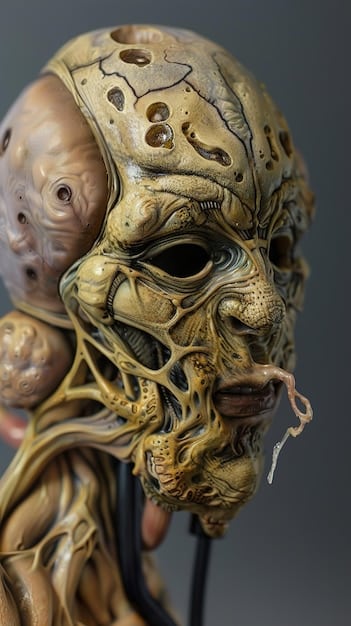
An era of groundbreaking prosthetics and gore
The late 70s and early 80s were a golden age for prosthetic makeup, transforming actors into truly horrifying beings. Artists like Rick Baker and Rob Bottin pushed the boundaries of what could be achieved with latex, foam, and paint, creating iconic monsters and shocking transformations.
- An American Werewolf in London (1981): David Naughton’s transformation scene remains a benchmark for practical effects, showcasing incredible mechanical puppetry and makeup that still holds up today.
- The Thing (1982): Rob Bottin’s work on John Carpenter’s masterpiece provided some of cinema’s most gruesome and imaginative creature designs, achieved entirely with practical means.
- Visceral Impact: The physical nature of these effects meant that blood and guts were often genuine materials, creating a level of discomfort and realism unmatched by early CGI.
In science fiction, the realism extended to spaceships, alien environments, and future technologies. The clunky, lived-in feel of many sci-fi visions from this era, like the original Star Wars trilogy (1977-1983), was a direct result of using physical models, carefully constructed sets, and intricate miniatures. These elements conveyed a sense of weight and purpose, making the fantastical worlds feel grounded.
The “used future” aesthetic of films like Alien was amplified by its practical elements, presenting a space that felt dirty, functional, and dangerously real. The tactile nature of these elements fostered a belief in the world presented, suspending disbelief in a way that sometimes eludes purely digital creations.
The rise of CGI and the shift in paradigm
The late 1980s and early 1990s marked a significant turning point with the rapid advancement and integration of computer-generated imagery (CGI) into mainstream filmmaking. While initially limited, CGI promised unprecedented flexibility and the ability to create visuals that would be impossible or prohibitively expensive with traditional practical effects. This new technology began to shift the paradigm of visual effects, slowly pushing practical effects from the forefront.
Early trailblazers like Tron (1982) and The Last Starfighter (1984) showcased the potential of CGI, but it was Terminator 2: Judgment Day (1991) and particularly Jurassic Park (1993) that truly demonstrated its revolutionary power. Jurassic Park, with its breathtakingly realistic dinosaurs, proved that CGI could achieve a level of photo-realism that practical effects simply couldn’t match for certain types of visual challenges.
Advantages and disadvantages of early CGI
While CGI offered immense creative freedom, its early iterations came with both benefits and drawbacks that filmmakers grappled with. The technology was nascent, expensive, and often required significant rendering time.
- Infinite Possibilities: CGI allowed for the creation of fluid, complex characters and environments that were impractical or impossible with physical models. Think liquid metal effects or entire virtual landscapes.
- Cost and Time: Initially, high-quality CGI was extremely costly and time-consuming, requiring specialized hardware and software, and skilled animators.
- “Uncanny Valley” Effect: Early CGI often suffered from an “uncanny valley” effect, where characters or creatures looked almost, but not quite, real, leading to a sense of unease or artificiality.
The promise of CGI was undeniably alluring. It allowed for iterative changes, infinite camera movements, and the ability to correct mistakes digitally, capabilities that practical effects simply could not offer. This flexibility rapidly made CGI the go-to solution for many visual effects challenges, leading to a decline in demand for traditional practical artists.
The speed and convenience of digital tools often overshadowed the tangible charm of practical work. As the technology matured and became more affordable, the balance shifted dramatically, leading to a perception that practical effects were outdated and cumbersome, a relic of a bygone era. This shift, however, also prompted a reevaluation of what was lost in the pursuit of purely digital images.
The resurgence and blending of techniques
Despite the initial dominance of CGI, a growing appreciation for the unique qualities of practical effects has led to a resurgence in recent years. Filmmakers and audiences alike have started to recognize that a purely digital approach can sometimes lack the weight, texture, and immediate believability that physical effects provide. This renewed interest isn’t about replacing CGI entirely, but rather about finding a harmonious blend.
Many modern blockbusters now intentionally incorporate practical effects for key elements, using CGI to enhance rather than to solely create. This hybrid approach leverages the strengths of both mediums: the tangibility and immediacy of practical effects for foreground action and character interaction, combined with the flexibility and scale of CGI for backgrounds, enhancements, and complex sequences.
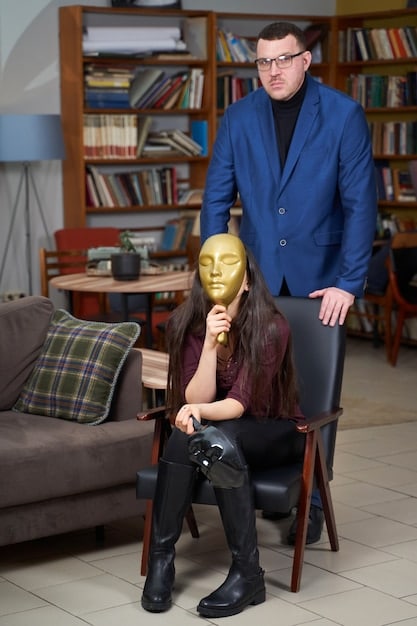
Modern filmmakers embracing practicals
Several contemporary directors have championed the return to practical effects, understanding their power to ground even the most fantastical stories in reality. Their efforts have showcased that well-executed practical effects can be just as, if not more, impactful than their digital counterparts.
- Christopher Nolan: A vocal advocate for practical effects, Nolan often uses large-scale physical stunts, miniatures, and in-camera trickery to achieve breathtaking sequences in films like Inception (2010), Interstellar (2014), and Dunkirk (2017).
- J.J. Abrams: For the rebooted Star Wars trilogy, Abrams consciously steered away from overly digital aesthetics, incorporating numerous practical creatures and sets to evoke the feel of the original films.
- Denis Villeneuve: In his science fiction epics like Blade Runner 2049 (2017) and Dune (2021), Villeneuve relies heavily on massive physical sets and real landscape photography, augmented with subtle CGI for atmosphere and scale.
This blending of techniques represents a maturation in visual effects, moving beyond an either/or mentality to a more integrated approach. The goal is no longer to simply choose between practical or digital, but to strategically employ each method where it can achieve the most compelling and believable result.
The emotional connection an audience makes with a physical effect, whether it’s a creature, a set, or an explosion, often feels more profound. There’s an inherent tactility that communicates authenticity, even when the scene is far from mundane. This understanding is driving a new wave of creativity, where the “lost art” is now a rediscovered and cherished tool in the filmmaker’s arsenal.
The enduring legacy and future of practical effects
The legacy of practical effects is undeniable, having shaped the landscape of cinema for over a century. From the earliest special effects pioneers to the masters of stop-motion and animatronics, their innovations laid the groundwork for all visual effects that followed. Even as CGI continues to advance at a breakneck pace, the principles of illusion and storytelling developed through practical techniques remain fundamental.
The future of practical effects lies not in a competition with CGI, but in a symbiotic relationship. As technology evolves, so too do the ways in which these traditional methods can be integrated and augmented. Imagine animatronic creatures with real-time digital skin textures, or miniature sets seamlessly extended by virtual environments. The possibilities for hybrid approaches are only just beginning to be fully explored.
Why practical effects will always matter
There are intrinsic qualities to practical effects that no amount of digital rendering can fully replicate. These qualities contribute to a film’s authenticity and an audience’s suspension of disbelief in unique ways.
- Physical Presence: Actors can interact tangibly with practical sets and creatures, leading to more natural and believable performances.
- Light Interaction: Real objects interact with light in ways that are inherently more complex and nuanced than even advanced digital simulations.
- Unpredictability and serendipity: The slight imperfections and unexpected events that can occur with physical effects often add to their charm and authenticity, creating happy accidents that enhance realism.
The enduring appeal of practical effects is a testament to the human desire for authenticity. In an increasingly digital world, there’s a comfort and wonder in knowing that some of the magic we see on screen was actually there, physically manipulated by skilled artisans. This connection to the tangible helps ground even the most fantastical narratives, ensuring they resonate on a deeper level.
The “lost art” is thus not truly lost, but rediscovered and revalued. It continues to inspire new generations of filmmakers and visual effects artists, reminding us that sometimes the most cutting-edge magic comes not from algorithms, but from skilled hands, keen eyes, and limitless imagination. The timeless masterpieces built on this foundation serve as a powerful reminder of cinematic ingenuity before the digital age.
| Key Point | Brief Description |
|---|---|
| ⭐ Golden Age Magic | Filmmakers used miniatures, forced perspective, and physical models to create realistic, large-scale illusions before CGI. |
| 👾 Creature Creation | Stop-motion animation and elaborate prosthetics brought iconic monsters and aliens to life with tangible dread. |
| 🔄 CGI Shift | The rise of CGI in the 90s provided new possibilities but sometimes lacked the physical presence of practical effects. |
| 🌌 Modern Blending | Today, practical and digital effects are often combined to maximize realism and creative impact in filmmaking. |
Frequently asked questions about practical effects
Practical effects are physical illusions created on film sets using actual objects, mechanics, and techniques like miniatures, matte paintings, puppetry, and prosthetic makeup. They involve tangible elements rather than solely computer-generated imagery. These methods provide a physical presence that actors can interact with, often leading to more realistic and grounded onscreen results.
Before CGI, large-scale destruction and epic scenes were mainly achieved using meticulously crafted miniatures and forced perspective. Filmmakers would build highly detailed models of cities, vehicles, or landscapes. These models were then filmed with clever camera angles and optical illusions to make them appear full-size, often enhanced with pyrotechnics for explosions and collapsing structures.
Several artists are celebrated for their groundbreaking work in practical effects. Ray Harryhausen revolutionized stop-motion animation, creating iconic creatures for films like Jason and the Argonauts. Pioneers like Rick Baker and Rob Bottin were masters of prosthetic makeup and animatronics, responsible for legendary horror transformations in movies such as An American Werewolf in London and The Thing.
CGI gained prominence due to its immense flexibility and ability to create visuals that were impossible or economically unfeasible with practical methods. It allowed for complex character animation, vast virtual environments, and greater creative freedom in post-production. The ability to iterate and correct mistakes digitally also made it an attractive option, leading to its widespread adoption over traditional techniques.
Yes, practical effects are experiencing a significant resurgence and are frequently used in modern films, often in conjunction with CGI. Many contemporary directors appreciate the tangible realism and physical presence that practical elements bring to a scene. This hybrid approach leverages the strengths of both techniques, using physical sets and props for foreground action, while CGI enhances backgrounds and complex sequences for greater impact.
Conclusion
The journey through the history of practical effects reveals a profound truth about filmmaking: magic often springs from ingenuity and craftsmanship. Before the digital age, every monstrous roar and every soaring spaceship was a testament to the skill and imagination of artists who worked with their hands to bring fantastical worlds to life. While CGI undeniably offers unparalleled capabilities, the unique charm, tactile realism, and enduring legacy of practical effects continue to captivate audiences and inspire filmmakers. Rediscovering the Lost Art of Practical Effects: How Forgotten Masterpieces Achieved Cinematic Magic Before CGI Domination shows us that these forgotten masterpieces remind us of the power of the tangible, a crucial ingredient in the timeless recipe for cinematic wonder that still resonates deeply today.
